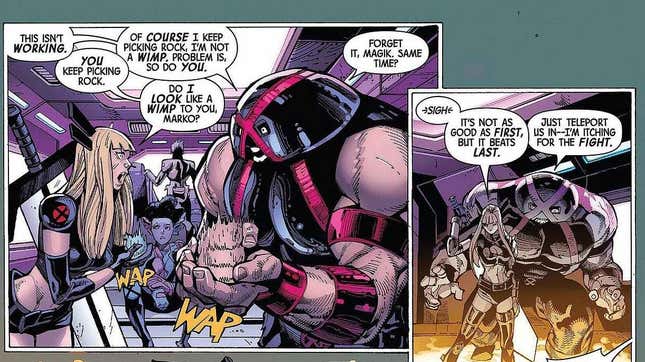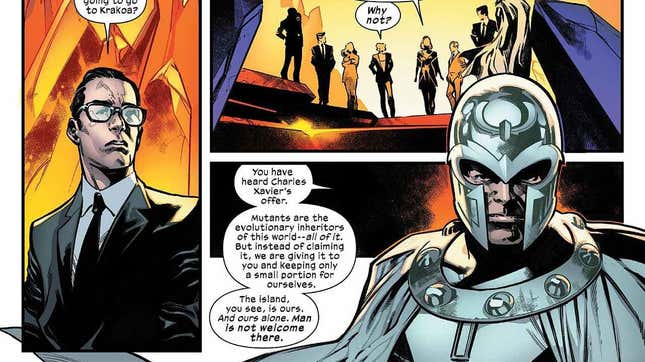Reboots are par for the course in superhero comics. Every few years a new creative team takes the reins and wants to shake things up in its own way. To do that, the story must first return to the status quo. Such is the case with the latest X-Men comic from writer Jed MacKay. It’s not exactly shocking to see the X-Men get a restart, but after the game-changing Krakoan era of the past five years, returning to the “status quo” feels more tiring than ever. Even with some loving nods to the X-Men’s long past, it’s hard to get excited about what is, for all intents and purposes, a good but overly familiar X-Men comic based on its first issue.
For the X-Men, the status quo is being hated by humans because of their identity as mutants, the superpowered next stage of evolution. That’s true in the new X-Men #1, which sees our merry mutants shacked up in an abandoned factory in Alaska after the mutant nation of Krakoa was dissolved, marking the end of an arc started by Jonathan Hickman back in 2019. The first issue begins with Beast guiding the local police chief through their new home in hopes of easing the worries of the nearby town. Meanwhile Cyclops, the team leader, is out on a mission to rescue Wolverine. The two threads of the debut issue work in tandem to establish the series’ status quo, deploying a familiar and reliable format for X-Men stories. The fluidity of penciler Ryan Stegman’s art is enhanced by Marte Gracia’s color, all of which helps punctuate both the humor and the more serious moments of MacKay’s writing.
Another important piece of the puzzle that the issue establishes is the new team. Any X-Men book relies heavily on having a good team and I have to say I’m pretty interested in the mutants MacKay has rounded up. While Cyclops, Beast, and Magneto feel like safe choices, the trio is supported by a more eclectic and loveable cast. Magik, Quentin Quire, Tempest, Psylocke, and Juggernaut fill out the team with their unique personalities that, so far, make for great action and comedy scenes. It’s always good to see a team roster combine old and new characters, while also making room for some of the less famous mutants.

For longtime readers, one of the most interesting parts of any new X-Men comic is figuring out what the new creative team’s favorite X-Men comics are, which typically comes across in the characters, setting, and stakes they establish. For MacKay, it’s pretty clear he has an affinity for Grant Morrison’s iconic and incredible New X-Men run, and it’s nice to see Morrison’s characters like Quire and Xorn show up and heavily reference events from that run.
The Morrison connections extend to the first issue’s main villain, a group called Fourth School. In the first issue, we get a lore dump that ties the new group directly to Morrison’s big bad, John Sublime and his U-Men. Beyond Morrison, the new series also has flavors of the 2010s Aaron and Bendis X-Men comics. The reveal that the X-Men’s new home is an abandoned sentinel factory feels like a homage to the time the team lived in the old Weapon X facility, while the entire opening tour from Beast feels ripped right out of Aaron’s first issue of Wolverine and the X-Men. However. One era of X-Men feels conspicuously absent as an influence on the new series: the one that directly preceded it.
Started in 2019 by Jonathan Hickman in the dual series event Houses of X/ Powers of X, the Krakoan era was a complete shattering of the decades-long X-Men status quo. The characters who have long been stand-ins for marginalized communities across the world, a group who have always had to play nice with their oppressors and murderers, finally decided to do something different. In the first year of the Krakoan era, Hickman established that mutants were now effectively immortal and had founded the mutant nation of Krakoa,) a place that would serve as a haven for mutants across the world and a place to create a unique mutant culture and society.

Over the course of the era, mutants showed the world they would no longer be oppressed and that humanity only lived because mutants allowed it. At one point mutants even terraform and claim Mars as part of their domain. It was a wild ride that felt truly groundbreaking. It also meant a lot for the mutant metaphor, showing that persecuted communities could in fact escape from under the heel of oppressors. Then, because of real-world creative and business decisions, Krakoa came to an end this year. The years-long story was by no means perfect but it proved that the X-Men could be more than they have always been. The end of Krakoa raised the question, where do we go from here?
That question is answered in X-Men #1 and it seems to be that we just go back to the old status quo and ignore Krakoa as much as possible. Yes, characters still reference events from the Krakoan era but none of the meteoric shifts that Hickman and his collaborators made have lasted. They can’t, not if the X-Men are to be what Marvel wants them to be for money-making purposes. Instead, the mutant population has dwindled tremendously and the X-Men have to keep on fighting the good fight against humans trying to kill them, while pretending that they have some moral high ground because they like to play nice with their oppressors. I know this has always been the way X-Men stories work but after Krakoa it just feels exceedingly bereft of meaning or purpose. It’s a shame because as far as status quo X-Men books go, MacKay’s is shaping up to be a good one based on the first issue.
It’s surprising how heavily X-Men #1 draws on Morrison’s work, considering all the similarities it has with the Krakoan era. Both were bold reinventions of the X-Men that broke the status quo but ultimately were ended unceremoniously and immediately had the majority of their impact on the larger canon retconned. Hell, Xorn in Morrison’s run was secretly Magneto! Now Xorn is just some guy because Marvel retconned it. Yet here we are, two decades removed from Morrison’s ugly exit from the series and the latest X-Men book is using his era as a major influence. At the same time, Krakoa is being ignored in all the ways that matter, but I can’t help but wonder about the X-Men writer two decades from now who brings it all back. It’s all a cycle comics readers know well, but because of Krakoa, I can’t help but be disappointed at how laid bare that cycle is.
.


